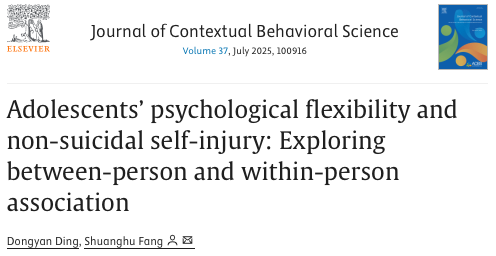Journal of Contextual Behavioral Science (JCBS)
Volume 37, July 2025
Authors
Dongyan Ding, Shuanghu Fang
Key Findings
• Pioneering RI-CLPM Analysis of Psychological Flexibility and NSSI for Adolescents.
• Psychological Flexibility Predicts Lower NSSI Over Time.
• Six-Dimensions of Psychological Flexibility Predict Lower Future NSSI.
• NSSI Doesn't Affect Psychological Flexibility: Unidirectional Impact.
• Cognitive Defusion and Committed Action Linked to Reduced NSSI at Between Level.
Abstract
Most research on the relationship between psychological flexibility and non-suicidal self-injury (NSSI) has been cross-sectional, focusing primarily on specific sub-dimensions of psychological flexibility (e.g., experiential avoidance, cognitive fusion) rather than its integrated constructs. To address these gaps, this study employed the Random Intercept Cross-Lagged Panel Model (RI-CLPM) to investigate the within-person dynamic relationships between psychological flexibility (including six sub-dimensions) and NSSI. A total of 1119 adolescents (mean age = 13.15, SD = 1.26; 50.2 % female) participated in the study, with data collected at six-month intervals over a 1.5 year period. The study revealed that higher psychological flexibility and its six sub-dimensions (i.e., present awareness, acceptance, cognitive defusion, self-as-context, values, and committed action) significantly predicted lower future NSSI over time, while NSSI did not significantly influence psychological flexibility or its sub-dimensions. Moreover, at the between-person level, committed action and cognitive defusion were negatively associated with NSSI. This research is the first to use RI-CLPM to differentiate within-person effects from between-person effects, providing a comprehensive analysis of the dynamic relationship between psychological flexibility (including its sub-dimensions) and NSSI. The findings offer a solid theoretical foundation for future interventions aimed at enhancing psychological flexibility to reduce NSSI among adolescents.
